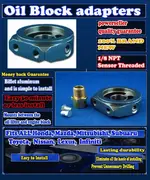I've had my oil pressure gauge all wired as far as the gauge goes, and its been in my pod for around 2 weeks, but i'm just getting to actually installing the sending unit (its electronic). Took off a bracket to get to where the stock switch sender is, got it out, and i have a BSPT (british standard pipe thread) to NPT (national pipe thread) adapter that fits into the standard hole (the engine and the stock switch are BSPT, the aftermarket sender and all the other fittings are NPT). I'm trying to keep both, so that i still have the dummy light in the dash. Problem is, the aftermarket sender totally dwarfes the stock switch, and i can't find any way to fit it in there, with the oil filter, intake manifold, and that bracket beneath them all being so close together. Can i use some other sending unit, or does it have to be a stewart warner to work with the stewart warner gauge?? Or, does anyone know another good way to do this??
Thanks a bunch for any help, i gotta get this taken care of by the end of this weekend, or i won't make it back to school, lol.
Thanks a bunch for any help, i gotta get this taken care of by the end of this weekend, or i won't make it back to school, lol.

